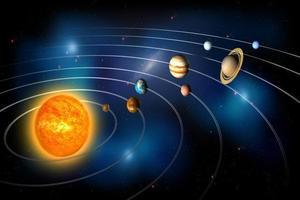13043831
unit 2.1.1 - OUR PLACE IN THE UNIVERSE
Resource summary
| Question | Answer |
| List the planets of the solar, in their order going away from the sun. | My - Mercury Very - Venus Easy - Earth Method - Mars Just - Jupiter Speeds - Saturn Up - Uranus Naming - Neptune |
| What is the solar system? | The solar system consists of the sun and all the objects held in orbit by it's gravity including: - 8 planets - moons - asteroids - comets |
| The Sun is the ___________ object in the Solar System. It contains ___.__% of the total mass of the entire Solar System. It mostly consists of __________ and helium. The Sun is massive compared to the Earth. Its diameter is over _____ times that of the Earth. | The Sun is the LARGEST object in the Solar System. it contains 98.8% of the total mass of the entire Solar System. It mostly consists of HYDROGEN and helium. The Sun is massive compared to the Earth. Its diameter is over 100 times that of the Earth. |
|
The Sun is the source of nearly all the _____________ we receive on Earth.
The energy source is nuclear __________. In nuclear fusion, _____________ nuclei are joined together to make helium ________.
This releases enormous amounts of ___________.
Image:
Fusion (binary/octet-stream)
|
The Sun is the source of nearly all the ENERGY we receive on Earth.
The energy source is nuclear FUSION. In nuclear fusion, HYDROGEN atoms are joined together to make helium ATOMS.
This releases enormous amounts of ENERGY.
Image:
Fusion (binary/octet-stream)
|
| Anywhere from 9.5 to 30 AU. | |
| True | |
| False | |
| The universe began as the result of an ………… known as the Big Bang. The universe continues to …………. away from the Big Bang. The universe is estimated to be 13.5 thousand …………… years old. | The universe began as the result of an EVENT known as the Big Bang. The universe continues to EXPAND away from the Big Bang. The universe is estimated to be 13.5 thousand BILLION years old. |
| Object 1 because, the black lines have shifted most to the right, indicating the wavelength of the light from this object has been stretched the most before reaching the Earth. | |
| Object 3 because, out of the 3 objects, the black lines have shifted the least indicating this object is closer to the Earth. | |
| It can be concluded that all 3 objects contain an element that is also present in the sun as all 3 objects have absorbed light energy at the same wavelengths. | |
| The Big Bang theory suggests the Universe exploded from a single point about 13.7 billion years ago. How does the presence of Cosmic Microwave Background Radiation (CMBR) support this theory? | CMBR is radiation left over from the immense amount of energy released in the Big Bang. The CMBR is a 'snapshot' of the oldest light in our universe, created just after the universe was came into existence. |
|
The name of the region from which it is believed that comets originate is the:
A Oort cloud
B Asteroid belt
C Inner part of the Solar System
Image:
Comet (binary/octet-stream)
|
A Oort cloud
Image:
Comet (binary/octet-stream)
|
| There are estimated to be between 100 and 400 ________ stars in the galaxy that contains our own solar system, the _________ _____. These stars are very ____ ______ and can only be examined by powerful ______________ using the ___________________ radiation emitted from them. | There are estimated to be between 100 and 400 BILLION stars in the galaxy that contains our own solar system, the MILKY WAY. These stars are very FAR AWAY and can only be examined by powerful TELESCOPES using the ELECTROMAGNETIC radiation emitted from them. |
| Light is a small part of the _________________ spectrum which our eyes are able to detect. All forms of electromagnetic radiation: • travel at the ______ ________ in a vacuum – ‘the speed of light’ • are _______________ waves • can be reflected and ___________________ | Light is a small part of the ELECTROMAGNETIC spectrum which our eyes are able to detect. All forms of electromagnetic radiation: • travel at the SAME SPEED in a vacuum – ‘the speed of light’ • are TRANSVERSE waves • can be reflected and REFRACTED |
| B 2cm 4 wave B's are the same length as 1 wave A Wave A wavelength = 8 cm Therefore wave B wavelength = 8 ÷ = 2 cm | |
| Use the equation: frequency = velocity ÷ wavelength to calculate the frequency of a radio wave with a wavelength of 2.0 m. wave speed = 300,000,000 m/s | frequency = velocity ÷ wavelength frequency = 300,000,000 ÷ 2 frequency = 150,000,000 Hz |
|
The part of the electromagnetic spectrum used to detect CMBR is:
A microwave
B radio wave
C infrared
Image:
Cmbr (binary/octet-stream)
|
A microwave
Microwaves are coming to earth from every direction in space. This is
called the cosmic microwave background radiation (CMBR). CBMR is considered to be evidence for the Big Bang theory.
Image:
Cmbr (binary/octet-stream)
|
| The part of the electromagnetic spectrum used to measure the temperature of planets is: A microwave B infrared C ultraviolet | C infrared All objects in the universe give off infrared (heat) radiation. The infrared image on the right shows active volcanoes on the surface of Jupiter's moon Io. |
Want to create your own Flashcards for free with GoConqr? Learn more.

